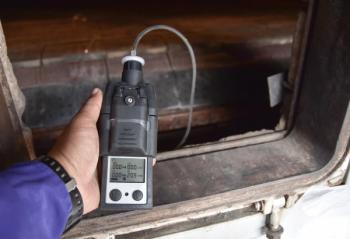
Determination of 17 Impurity Elements in Aluminum Nitride by Inductively Coupled Plasma Optical Emission Spectrometry with Microwave Digestion
Key Takeaways
- Aluminum nitride is crucial for semiconductor applications due to its high thermal conductivity and mechanical performance, impacting industries like electronics and defense.
- Current standards for aluminum nitride impurity analysis are limited, necessitating new methods for accurate trace element determination.
An analytical method was established for determining the contents of 17 impurity elements in aluminum nitride by inductively coupled plasma optical emission spectrometry. The experiment investigated a dissolution method for samples, working conditions of the instrument, analytical spectral lines, matrix interference and correction methods, and detection limits.
It has been reported that the current development direction of key strategic materials mainly includes special alloys for high-end equipment in fields such as aerospace, marine engineering, and high-speed railway, as well as new energy materials such as solar cells and lithium-ion batteries, advanced semiconductor materials such as silicon, germanium, gallium nitride, and aluminum nitride in the "Research on the Strategy for Building a Strong New Materials Nation Towards 2035.” (1) As the "future star" in the semiconductor field, aluminum nitride offers outstanding properties, including high thermal conductivity, good insulation, large bandgap width, and excellent mechanical performance. It is an ideal heat dissipation and packaging material for the new generation of large-scale integrated circuits, semiconductor module circuits, and high-power devices. It is not only an essential fundamental key material for supporting the development of trillion industries such as electronic information, but also a strategic key material that affects national security, such as aviation and military defense (2-5). Research scholar Ding Liwen (6) reported that the contents of trace impurity elements in aluminum nitride are an important factor affecting the performance of the powder. Therefore, it is important to determine the contents of trace impurity elements in aluminum nitride accurately.
At present, there is a lack of standards for the chemical composition analysis of aluminum nitride, only GB/T 42274-2022 "Determination of the Content and Distribution of Trace Elements (Magnesium, Gallium) in Aluminum Nitride Materials--Secondary Ion Mass Spectrometry" (7) and YB/T 4799-2018 "Iron and Steel--Determination of Aluminum Nitride Precipitated Phase Content--Inductively Coupled Plasma Atomic Emission Spectrometric Method After Electrolytic Separation" (8) are available. These two standards are for the determination of magnesium and gallium contents in high-purity aluminum nitride and the determination of aluminum nitride content in steel production, respectively. Analytical standards for the contents of trace impurity elements in aluminum nitride are not found. The determination methods of trace impurity elements mainly include atomic absorption spectrometry (AAS) (9,10), inductively coupled plasma optical emission spectrometry (ICP-OES) (11-13), inductively coupled plasma mass spectrometry (ICP-MS) (14,15), and glow discharge mass spectrometry (GD-MS) (16). Although the AAS method has the advantages of high sensitivity and good precision, it cannot achieve the simultaneous determination of multiple elements and has relatively low efficiency. The ICP-MS method and the GD-MS method are fit for the rapid and simultaneous determination of trace impurity elements in high-purity materials, and the GD-MS method belongs to a semi-quantitative analysis method.
Tokusan Corporation of Japan has a long history and advanced technology in the production and research of aluminum nitride powder, which holds over 70% of the global high-end aluminum nitride powder market. It is reported that the purity of some high-end aluminum nitride products can reach 99.8% or higher. However, the research on the preparation technology of aluminum nitride powder in some other countries started relatively late. The purity of the produced aluminum nitride is mainly concentrated between 90% and 98%. ICP-OES can meet the determination requirements of trace impurity elements in products, which has the advantages of high sensitivity, high precision, wide dynamic range, and simultaneous determination of multiple elements.
Until now, no relevant reports have been found on the research for determining trace impurity elements in aluminum nitride by ICP-OES. In this study, aluminum nitride was decomposed by sulfuric acid under microwave digestion conditions. The contents of boron, calcium, copper, iron, magnesium, manganese, molybdenum, nickel, potassium, silicon, sodium, titanium, tungsten, vanadium, zinc, zirconium, and lead were determined by ICP-OES. An analytical method for the rapid and simultaneous determination of 17 trace impurity elements in aluminum nitride was developed. Through methodological evaluation, the precision and accuracy were found to be satisfactory.
Experimental
Instrumentation
A 5110 Inductively coupled plasma optical emission spectrometer (Agilent Corporation) and a Mars 6 microwave digestion (CEM Corporation) were used. The working conditions of instruments are shown in Tables I and II. To view figures and tables, click on figure/table, and click on Open Image in New Tab.
Reagents and Standard Solutions
Standard stock solution for single element: 100 μg/mL, boron, calcium, copper, iron, magnesium, manganese, molybdenum, nickel, potassium, silicon, sodium, titanium, tungsten, vanadium, zinc, zirconium, and lead. Mixed standard working solution: 20 μg/mL, dilute and mix single-element standard stock solutions of boron, calcium, copper, iron, magnesium, manganese, molybdenum, nickel, potassium, silicon, sodium, titanium, tungsten, vanadium, zinc, zirconium, and lead. Sulfuric acid. Deionized water (18.2MΩ·cm).
Aluminum matrix solution: 10 mg/mL, weigh 5.0 g of high-purity aluminum (wAl≥99.999%) and place in a polytetrafluoroethylene beaker, cover with a watch glass, add 50 mL of sulfuric acid (1+1) solution in several portions, heat slowly until completely dissolved, boil for several minutes, cool, and transfer to a 500 mL plastic volumetric flask. Dilute with water to the mark and mix well.
Transfer the aluminum matrix solution with an aluminum content equivalent to that of the sample into a set of 50 mL volumetric flasks. Add 0 mL, 0.50 mL, 1.00 mL, 2.00 mL, 4.00 mL, 6.00 mL, and 8.00 mL of the mixed standard working solution in turn, and add 15 mL of sulfuric acid (1+2) solution. Dilute with water to the mark and mix well.
Sample Preparation
Weigh 0.25 g (accurate to 0.0002 g) of the sample into the microwave digestion tank accurately, add 15 mL of sulfuric acid (1+2) solution, and digest according to the program in Table II. After dissolving completely, cool to room temperature, transfer to a 50 mL plastic volumetric flask, dilute to the mark with water, and mix well. Conduct a reagent blank test along with the sample.
Results and Discussion
Selection of Dissolving Method
Aluminum nitride has a stable covalent structure, which makes it stable at normal temperature and pressure, and difficult to dissolve in inorganic acids. Considering that aluminum nitride and aluminum oxide have similar chemical properties in some respects, use the method of GB/T 6609.1-2018 "Chemical Analysis Methods and Determination of Physical Performance of Alumina--Part 1: Determination of Trace Elements Content--Inductively Coupled Plasma Atomic Emission Spectrometry Method" (17) for reference. The dissolving conditions of aluminum nitride under different heating conditions in sulfuric acid medium were investigated, as shown in Table III. It can be seen from Table III that aluminum nitride was hardly dissolved either when heated at 200 ℃ for 16 h under normal pressure in sulfuric acid medium or when heated at 280 ℃ for 5 h under normal pressure in sulfuric acid medium, but aluminum nitride was completely dissolved with microwave digestion under heating and pressure for about 2 h. The sample solution was clear and transparent, and the loss of volatile elements such as boron and silicon was avoided under a closed container. Considering the economy and efficiency of the experiment comprehensively, microwave digestion was selected as the dissolving method.
Selection of Sample Weight
The weight of the sample is an important factor affecting the dissolving status. If the weight of the sample is too heavy, the sample will not be dissolved completely, and the analytical result will be low. If the weight of the sample is too light, the elements with low contents that are below the detection limit will not be detected. The experiment investigated the dissolving status under different weights of sample, such as 0.10 g, 0.25 g, and 0.50 g, respectively, by microwave digestion in different amounts of sulfuric acid medium, as shown in Table IV. It can be seen from Table IV that 0.50 g of the aluminum nitride sample was not completely dissolved in 10 mL~20 mL of sulfuric acid medium, while 0.25 g of the aluminum nitride sample could be completely dissolved in 15 mL~20 mL of sulfuric acid medium, leaving the solutions clear and transparent. Considering the dissolving status of the sample and the detection limits, 0.25 g was selected as the sample weight.
Selection of Analytical Wavelengths
Under the optimal working conditions of the instrument, after scanning the 10 mg/mL aluminum matrix solution at the analytical wavelengths with relatively high sensitivity of each element, the obtained spectra were superimposed with the spectral lines of 1.00 μg/mL (excluding aluminum matrix) standard solution of each single element to be measured. The spectral lines with regular peak shape, low background signal, small spectral interference, and high sensitivity were selected as the analytical spectral lines of each element to be measured (18), as shown in Table V.
Matrix Effect and Correction
Referring to the product standard SJ 20637-97 "Specification for AIN Powder for Electric Ceramics” (19), it is stated that the aluminum content in aluminum nitride is more than 60%. The experiment investigated the ratio of emission intensity for each element (1.00 μg/mL) to be measured in the exist of 5 mg/mL and 10 mg/mL aluminum matrix, as shown in Figure 2. It can be seen from Figure 2 that, with the increase in the amount of aluminum matrix, the ratios of the emission intensities of each element showed a downward trend. The recovery rates of some elements, such as Mo, Ni, K, Si, and Pb, were lower than 80%, indicating that the aluminum matrix had a certain suppressive effect on the emission intensity of the elements to be tested. Therefore, matrix matching method, standard addition method and internal standard method (Sc internal standard, Cs internal standard) were adopted to correct the matrix effect, and the influences of different correction methods on the analytical results were investigated, as shown in Table VI, where it can be seen that both the matrix matching method and the standard addition method can compensate the spectral interferences of matrix well, and there is no significant differences between the analytical results. However, when Sc was used as the internal standard with the internal standard method for correction, the analytical results of Si, Mo, and W were lower, and when Cs was used as the internal standard with the internal standard method for correction, the analytical results of K, Si, and Na were lower, and the recovery rates were all lower than 90%. It indicated that although the internal standard method can correct the spectral drifts of most elements, it has a certain selectivity. The spectral compensation effect was better when the molecular weight of the element to be measured was close to that of the internal standard element. It was necessary to use two or three kinds of internal standards for simultaneous correction to achieve a better effect. Considering the complexity and efficiency of the standard addition method, the matrix matching method was selected to correct the matrix interferences in the experiment.
Calibration Curve and Detection Limit
We then created the calibration curve with the mass concentration as abscissa and the emission intensity as ordinate. The linear equation and correlation coefficient of the calibration curve are shown in Table VII. According to the regulations of the International Union of Pure and Applied Chemistry (IUPAC), the blank solution was continuously determined 11 times under repeatable conditions, the detection limit was calculated at 3 times the standard deviation of the blank solution, and the quantification limit was calculated at 10 times the standard deviation of the blank solution. It can be seen from the data in Table VII that the detection limit of this method was basically the same as that of Wu and associates (20), who determined the contents of sodium, tungsten, and other elements in aluminum nitride powder by ICP-MS, and Qiu and associates (21), who determined the contents of potassium and sodium in aluminum nitride by flame atomic absorption spectrometry, which indicated that this method had enough sensitivity.
Precision Test
According to the experimental step, analyze each element to be measured in samples 1, 2, and 3 seven times and calculate the relative standard deviation (RSD) of each element. It can be seen from Table VIII that the RSD of each element was between 0.91% and 8.96%, indicating that this method had good precision and the analytical results were stable and reliable.
Accuracy Test
As there are no standard materials of aluminum nitride at present, recovery tests and method comparisons were used to investigate the accuracy of the method (22). A certain number of elements to be measured were added to samples 1, 2, and 3, and the determination was carried out according to the experimental step, as shown in Table IX. It can be seen in Table IX that the recovery rate of elements measured ranged from 92.9% to 108.0%. Elements whose contents were within 0.01% in samples 1, 2, and 3 were determined simultaneously by this method and ICP-MS. The results from these two analytical methods were statistically analyzed by the mean consistency test (T-test) method, as shown in Table X, where the resulting statistics were less than the critical value at the significance level a=0.05, indicating that there were no significant differences between the results of the two analytical methods.
Conclusions
Aluminum nitride was dissolved with sulfuric acid under microwave digestion conditions. Factors such as sample weight, analytical spectral lines, instrument working conditions, and matrix interferences were investigated in the experiment, and an inductively coupled plasma optical emission spectrometry method for determination of 17 trace impurity elements in aluminum nitride were developed. The matrix matching method was adopted in the standard solution to compensate for the spectral interferences of the matrix. The calibration curve had good linearity, and the detection limit, precision, and accuracy of this method all met the requirements of analysis. Compared with other methods, this method is simple to operate, requires less acid, has a shorter sample dissolving time, causes less sample loss, and has high precision and accuracy. It is suitable for the rapid determination of trace impurity elements in the daily analysis of aluminum nitride samples. As there are no standard materials of aluminum nitride at present, only the standard addition method and method comparison can be adopted to investigate the accuracy. In the future, the development of standard materials of aluminum nitride will make it more convenient to evaluate the accuracy of the method.
References
- Xie, M.; Gan, Y.; Wang, H. Research on New Material Power Strategy by 2035. Strategic Study CAE. 2020, 22 (5), 1-9. DOI:
10.15302/J-SSCAE-2020.05.001 - Zhang, Z. R.; Qin, M. L.; Wu, H. Y.; et al. Research Progress and Preparation Method of Aluminum Nitride Powder. Powder Metall. Technol. 2021, 39 (4), 373–382. DOI:
10.19591/j.cnki.cn11-1974/tf.2020070004 - Jiang, Z. Q.; Liu, Y. Z.; Xue, L. Q.; et al. Research Progress of the Aluminum Nitride Powder Preparation Technology. Semicond. Technol. 2019, 44 (8), 577–582. DOI:
10.19591/j.cnki.cn11-1974/tf.2020070004 - Ni, H. J.; Ni, W.; Ma, L. B.; et al. Research Status and Development Trend of Preparation Technologies for High Thermal Conductivity AlN Ceramic Substrates. Mod. Chem. Ind. 2017, 37 (7), 45-50.
DOI: 10.16606/j.cnki.issn0253-4320.2017.07.011 - Lv, S. S.; Zhou, Y. X.; Ni, W.; et al. Research Status and Development Trend of Preparation Technologies for High Thermal Conductivity Aluminum Nitride Ceramics. J. Ceram. 2018, 39 (6),672–675. DOI:
10.13957/j.cnki.tcxb.2023.02.002 - Juyeon, H.; Kanhu, C. N.; Cheol, H. S.; et al. Morphology Engineering of Low-Temperature-Synthesized Aluminum Nitride. J. Mater. Res. Technol. 2024, 33: 4400-4409.
DOI: 10.1016/j.jmrt.2024.10.129 - National Standards of the People’s Republic of China. Determination of the Content and Distribution of Trace Elements (Magnesium, Gallium) in Aluminum Nitride Materials--Secondary Ion Mass Spectrometry; GB/T 42274-2022; China, 2022.
https://openstd.samr.gov.cn/bzgk/std/newGbInfo?hcno=A04DD004BD87D5ADBCFFF9F1942C7F8E - National Standards of the People’s Republic of China. Iron and Steel--Determination of Aluminum Nitride Precipitated Phase Content--Inductively Coupled Plasma Atomic Emission Spectrometric Method After Electrolytic Separation; YB/T 4799-2018; 2018.
https://www.cssn.net.cn/cssn/productDetail/db6953c141fc168e02495d8cfbf8007b - Lu, G. P.; Wang, Z.; Qiu, D. R.; Zou, H. J.; He, Y. F. Direct Determination of Copper, Iron, and Sodium in High-Purity Alumina by Slurry Introduction Furnace Atomic Absorption Spectrometry with Smith-Hieftje Background Correction. Spectrosc. Spectral Anal. 2011, 31 (1), 244–248. DOI:
10.3964/j.issn.1000-0593(2011)01-0244-05 - Mo, S. M.; Li, A. C.; Qiu, C. D.; et al. Determination of Potassium and Sodium in Aluminum Nitride Powder by Microwave Digestion--Flame Atomic Absorption Spectrometry. Metall. Anal. 2020, 40 (9), 70–74.
- Zhao, Z. Y.; Mei, L. P.; Shi, X.; Jiang, W. Determination of Iron, Titanium, Silicon, Chromium in High Purity Alumina by Suspension Sampling Inductively Coupled Plasma Emission Spectrometry. Chem. Anal. Meter. 2017, 26 (1), 55–57.
- Joaquim, A. N.; Daniela, S.; Clance, D. B. A. et al. Determination of Rare Earth Elements in Geological and Agricultural Samples by ICP-OES. Spectroscopy 2017, 32 (10), 32–36.
- Hu, Y. Q.; Cheng, W. C.; Zhi, Y. C.; et al. Simultaneous Determination of 11 Elements in Chromites by Inductively Coupled Plasma Atomic Emission Spectrometry with HCI-HNO3-HF-HCIO4 Digestion Method. Chin. J Anal. Lab. 2016, 35 (11), 1312–1316.
- Nam, K. H.; Isensee, R.; Infantino, G.; Putyera, K.; Wang, X. Microwave-induced Combustion for ICP-MS: a Generic Approach to Trace Elemental Analyses of Pharmaceutical Products. Spectroscopy 2011, 26 (4), 36–41.
- Aaron, H. Determination of Elemental Impurities in Antacids by ICP-MS According to the Validation Protocols Defined in USP Chapters and ICH Q3D Step 4 Guidelines. Spectroscopy 2017, 32 (7), 36–40.
- Hu, F. F.; Wang, C. H.; Li, J. Dong. Impurities Concentration Detection in Oxide Aluminum by Direct Current Glow Discharge Mass Spectrometry. J. Chin. Mass Spectrom. Soc. 2014, 35 (4), 335–340. DOI:
10.7538/zpxb.youxian.2014.0029 - National Standards of the People’s Republic of China. Chemical Analysis Methods and Determination of Physical Performance of Alumina--Part 1: Determination of Trace Elements Content--Inductively Coupled Plasma Atomic Emission Spectrometry Method; GB/T 6609.1–2018; 2018. https://std.samr.gov.cn/gb/search/gbDetailed?id=71F772D82BDFD3A7E05397BE0A0AB82A
- Kenneth, N. How to Choose the Correct Wavelength in ICP-OES. Spectroscopy 2019, 34 (8), 24–26.
- Military Standards of the Electronic Industry of the People's Republic of China. Specification for AIN Power for Electric Ceramics; SJ 20637-97; 1997. http://www.csres.com/detail/27813.html
- Wu, Q. Y.; Sun, J. M.; Zhang, W. Q.; et al. Determination of Sodium, Tungsten, Iron, Zinc, Titanium, and Manganese in Aluminum Nitride Powder by Super Microwave Digestion Inductively Coupled Plasma Mass Spectrometry with Collision Cell. Metall. Anal. 2022, 42 (7), 19–25. DOI:
10.13228/j.boyuan.issn1000-7571.00948 - Qiu, C. D.; Mo, S. M.; Li, A. C.; et al. Determination of 15 Impurity Elements in High Purity Aluminum Nitride Powder by Inductively Coupled Plasma Mass Spectrometry with Microwave Digestion. Phys. Test. Chem. Anal. Part B: Chem. Anal. 2021, 57 (12), 1110–1114. DOI:
10.11973/lhjy-hx202112009 - Deborah, K. B. Influence of Spectral Interferences on the Reliability of Data when using Analyte Addition Techniques with ICP-OES. Spectroscopy 2020, 35 (2), 53–56.
Hu Xuan, Cheng Zihui, and Zhang Lijiu are with Guobiao (Beijing) Testing & Certification Co., Ltd., in Beijing, China. Direct correspondence to: chengzihui@gbtcgroup.com
Newsletter
Get essential updates on the latest spectroscopy technologies, regulatory standards, and best practices—subscribe today to Spectroscopy.





